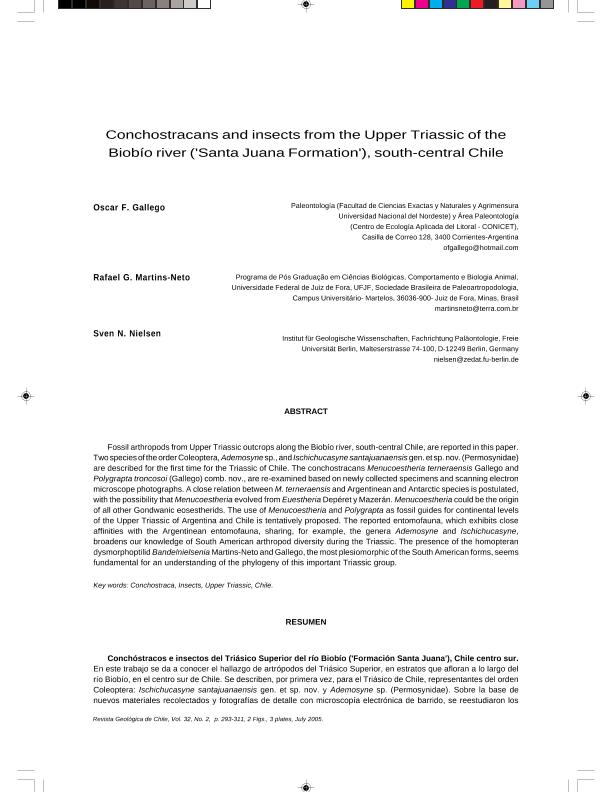Artículo
Fossil arthropods from Upper Triassic outcrops along the Biobío river, south-central Chile, are reported in this paper. Two species of the order Coleoptera, Ademosyne sp., and Ischichucasyne santajuanaensis gen. et sp. nov. (Permosynidae) are described for the first time for the Triassic of Chile. The conchostracans Menucoestheria terneraensis Gallego and Polygrapta troncosoi (Gallego) comb. nov., are re-examined based on newly collected specimens and scanning electron microscope photographs. A close relation between M. terneraensis and Argentinean and Antarctic species is postulated, with the possibility that Menucoestheria evolved from Euestheria Depéret y Mazerán. Menucoestheria could be the origin of all other Gondwanic eosestherids. The use of Menucoestheria and Polygrapta as fossil guides for continental levels of the Upper Triassic of Argentina and Chile is tentatively proposed. The reported entomofauna, which exhibits close affinities with the Argentinean entomofauna, sharing, for example, the genera Ademosyne and Ischichucasyne, broadens our knowledge of South American arthropod diversity during the Triassic. The presence of the homopteran dysmorphoptilid Bandelnielsenia Martins-Neto and Gallego, the most plesiomorphic of the South American forms, seems fundamental for an understanding of the phylogeny of this important Triassic group En este trabajo se da a conocer el hallazgo de artrópodos del Triásico Superior, en estratos que afloran a lo largo del río Biobío, en el centro sur de Chile. Se describen, por primera vez, para el Triásico de Chile, representantes del orden Coleoptera: Ischichucasyne santajuanaensis gen. et sp. nov. y Ademosyne sp. (Permosynidae). Sobre la base de nuevos materiales recolectados y fotografías de detalle con microscopía electrónica de barrido, se reestudiaron los conchóstracos Menucoestheria terneraensis Gallego y Polygrapta troncosoi (Gallego) comb. nov. Se destaca la estrecha relación entre M. terneraensis Gallego y otras especies de Argentina y Antártica. Se menciona la posibilidad de que este género haya evolucionado a partir de especies de Euestheria Depéret y Mazerán, y que a su vez Menucoestheria Gallego haya dado origen a todos los eosestherideos gondwánicos. Se propone, tentativamente, el empleo de Menucoestheria y Polygrapta como fósiles guías para los niveles continentales del Triásico Superior de Argentina y Chile. La entomofauna registrada muestra estrechas afinidades con las faunas argentinas, con las que comparte los géneros Ademosyne e Ischichucasyne, y amplía el conocimiento sobre la diversidad de artrópodos durante el Triásico en Sudamérica. La presencia del homóptero dysmorphoptilideo Bandelnielsenia Martins-Neto y Gallego, la más plesiomórfica de las formas sudamericanas, resulta fundamental para comprender la filogenia de este importante grupo triásico
Conchostracans and insects from the Upper Triassic of the Biobío river (“Santa Juana Formation”) from Chile
Título:
Conchóstracos e insectos del Triásico Superior del río Biobío ('Formación Santa Juana'), Chile centro sur
Fecha de publicación:
12/2005
Editorial:
Servicio Nacional de Geología y Minería
Revista:
REVISTA GEOLóGICA DE CHILE
ISSN:
0716-0208
e-ISSN:
0717-618X
Idioma:
Español
Tipo de recurso:
Artículo publicado
Clasificación temática:
Resumen
Palabras clave:
Conchóstracos
,
Insectos
,
Triásico Superior
,
Chile
,
Conchostraca
,
Insects
,
Upper Triassic
Archivos asociados
Licencia
Identificadores
Colecciones
Articulos(CECOAL)
Articulos de CENTRO DE ECOLOGIA APLICADA DEL LITORAL (I)
Articulos de CENTRO DE ECOLOGIA APLICADA DEL LITORAL (I)
Citación
Gallego, Oscar Florencio; Martins-Neto, Rafael G.; Nielsen, Sven Nikolaus; Conchostracans and insects from the Upper Triassic of the Biobío river (“Santa Juana Formation”) from Chile; Servicio Nacional de Geología y Minería ; REVISTA GEOLóGICA DE CHILE; 31; 2; 12-2005; 293-311
Compartir
Altmétricas




